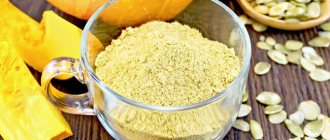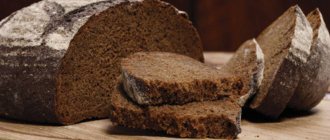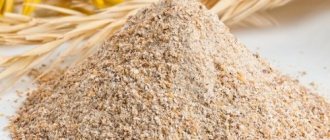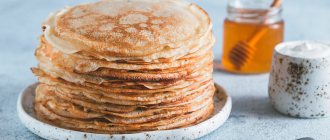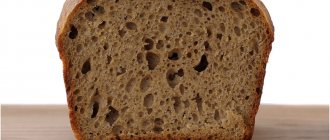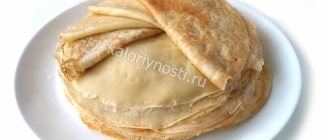Calorie table for different types of flour
The calorie content of flour and BJU (proteins/fats/carbohydrates) varies depending on the type of product.
To select low-fat flour that is suitable for diabetics or obese patients, it is necessary to consider the beneficial properties
Common types with nutritional value:
| View | Calories (100 g) | BZHU (100 g) |
| Wheat (highest grade) | 339 | 11/1,4/70 |
| Wheat (coarse grind) | 312 | 11/1,5/65 |
| Wheat (whole grain) | 302 | 13/1,5/58 |
| Rye | 295 | 12/2/35 |
| Coconut | 456 | 20/15/60 |
| Almond | 606 | 26/54,5/13 |
| Rice | 365 | 6/1,5/85 |
| Corn | 325 | 7/2/76 |
| Oatmeal | 375 | 12/6/60 |
| Barley | 300 | 9/1/60 |
| Linen | 273 | 36/10/5 |
| Chickpeas | 389 | 22,2/7/58 |
| Buckwheat | 349 | 13,8/1/,72 |
| Pea | 292 | 9/1,7/61 |
| Pumpkin | 301 | 33/9/22 |
| Spelled | 150 | 12,/0,7/25 |
| Cheremukhovaya | 120 | 7,8/0/21 |
| Amaranth | 293 | 9/1,7/60,5 |
| Sesame | 468 | 46/12/30 |
Low-calorie varieties are bird cherry and spelled. If you are more used to wheat, it is recommended to use the whole grain variety.
What flour is good for diabetics and those losing weight?
To choose low-fat flour suitable for patients with diabetes or obesity, you need to consider the beneficial properties:
- soy – contains protein, strengthens bone and cartilage tissue, muscle corset;
- corn - contains vitamins A and E, improves bile flow, stabilizes the gastrointestinal tract, makes the vessels and arteries of the heart muscle strong and durable;
- buckwheat – stabilizes the amount of glucose in the blood;
- oatmeal – lowers cholesterol, normalizes stomach function;
- flaxseed – cleanses of decay products, toxins, starts accelerated food processing, promotes weight loss;
- coconut – accelerates the breakdown of fat cells, gives a feeling of fullness and suppresses hunger, fights constipation and stabilizes the gastrointestinal tract;
- almond – lowers cholesterol, triggers the body’s natural production of insulin, cleanses the kidneys, protects blood vessels, prevents the absorption and deposition of carbohydrates.
Advice! It is recommended to exclude wheat variety from the diet, replacing it with whole grain bran.
Types, nutritional value and calorie content of flour: which is healthier on a diet
If you are losing weight and have diabetes, you should completely avoid premium wheat flour because of the high calorie content of this product and the high starch content in it. Low-calorie types are corn, spelled, buckwheat, rye and flaxseed flour. From these types you can prepare a variety of baked goods, which in taste are in no way inferior to products made from white wheat flour. Coconut and almond flour are useful for weight loss, since these products contain a lot of fiber and polyunsaturated fats, which speed up metabolism and are necessary for the normal functioning of the human body.
What foods should you limit?
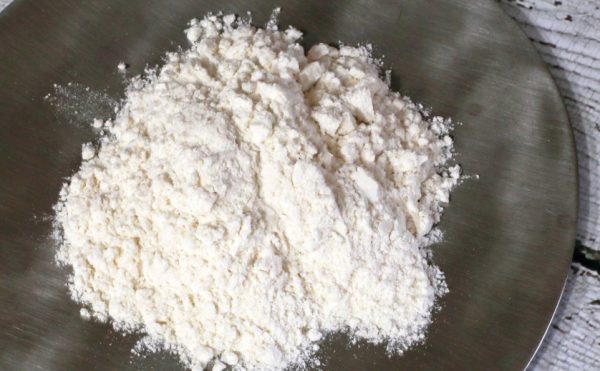
Diabetics should avoid all white flour as it contains a lot of calories. From a dietary point of view, this variety is considered the least useful, since it inhibits digestion and complicates the digestion of food.
Note! Despite the lower calorie content of whole grain flour, it contains the same starch. Therefore, even limiting it in the daily diet will lead to increased blood sugar and weight gain.
Rice flour, although it contains many microelements, is not considered healthy due to the presence of dietary fiber. Therefore, its amount in the diet must be reduced to a minimum, replacing it with species that are valuable from the point of view of healthy nutrition.
Be sure to read: How many calories are in oatmeal porridge with water and milk, calorie content of oatmeal with honey per 100 grams
Why is white wheat flour harmful?
Wheat flour does more harm than good. Regardless of the variety, it does not exclude dietary fiber, affects health and leads to weight gain.
This simple, refined product contains gluten, a protein derivative of gluten, which glues the contents of cereals together and causes diseases.
Note! With regular consumption of dough made from premium flour, people may eventually develop celiac disease, that is, gluten intolerance, for this reason it is important to reduce the frequency of their use and monitor nutrition.
The gluten content will depend on the variety and grinding of the product: usually it is higher in premium varieties.
Whole grain flour for weight loss
Due to the fact that during grain grinding it is not cleared of the outer shell, which is rich in fiber, eating baked goods made from whole grain flour promotes weight loss.
Moderate consumption (no more than 100 g of baked goods per day) helps improve the functioning of the stomach and intestines. The body is cleansed of toxins, and food is not stored as fat, but is processed into energy, increasing the stamina and performance of the body.
Flour is valued by those losing weight for its low glycemic index and the content of “slow” carbohydrates, which take a long time to digest and give a feeling of fullness for a longer time. However, you should eat dishes made from wholemeal flour in the first half of the day and do not abuse the daily dose, since the calorie content of whole grain flour is not low (298 kcal per 100 g).

Whole grain flour is a healthy food product that is high in micro- and macroelements, as well as fiber. Dishes made from flour made by one-time grinding have a positive effect on the health of adults and children, and are also suitable for people following a diet, vegetarianism and a healthy diet.
Moderate consumption (no more than 100 g of baked goods per day) helps improve the functioning of the stomach and intestines. The body is cleansed of toxins, and food is not stored as fat, but is processed into energy, increasing the stamina and performance of the body.
How to replace white wheat flour?
A beneficial solution for the daily menu of diabetics is the complete exclusion of the product, but often most patients are not capable of such sacrifices.
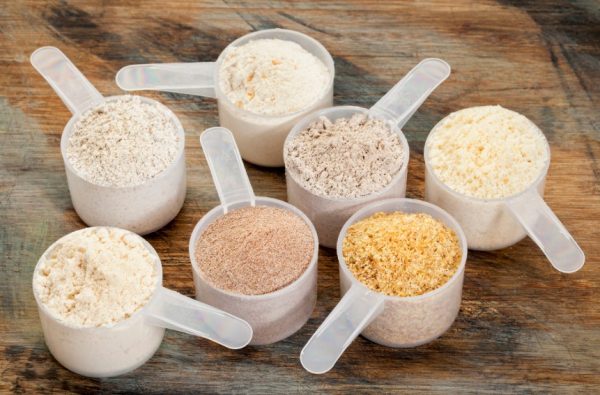
Different types of flour
An alternative in this case would be to replace wheat flour with healthy types:
- spelled;
- spelt;
- coarse buckwheat;
- bran;
- cereals;
- airy cookies and bread.
Instead of traditional white flour, it is recommended to purchase coarsely ground wallpaper, which is suitable for baking baked goods and unsweetened cookies.
The healthiest flour is other types
Flour itself is high in calories, so people with diabetes or overweight are advised to consume a strictly limited amount of it per week.
The best option is considered to be up to 500 kcal per week. Useful varieties that are preferable to use instead of the classic type are buckwheat, spelled, oatmeal, rye and others.
Spelled or spelt
Spelled flour
One of the purest and lightest whole grain varieties of the product. Made from wheat germ, it is rich in healthy protein and nutritious fiber.
The proteins in its composition differ in structure, are absorbed faster and do not provoke an allergic reaction. It is suitable for diabetics, allergy sufferers and those with complete gluten intolerance.
Be sure to read: How many calories are in pilaf with chicken, beef, lamb, pork and without meat, how to reduce calories
Peeled rye or wallpaper flour
Rye flour
is considered the coarsest and most sticky and does not undergo deep processing. Rye flour contains whole parts of the grains along with the shells.
Therefore, this variety is considered more beneficial for the body, it is digested and absorbed faster without complications, does not inhibit metabolism, and helps cleanse the body.
The content of minerals and trace elements in it is increased. A suitable option for baking homemade rye bread.
Coarse wheat wallpaper
This variety is different from the usual white flour; it is obtained from purified, natural whole wheat grains.
Note! There are 3 factories on the territory of the Russian Federation that produce flour of this type: the Solnechny agricultural complex, Belovodye and Diamant. When making a purchase, make sure that the packaging has a special eco-test sign.
This cooking method retains all the valuable vitamins and minerals found in regular flour, but at the same time reduces the gluten and starch content. Suitable for homemade lean and sweet baking.
Buckwheat flour
Buckwheat flour
A dietary option for those who cannot do without baked goods. Made from buckwheat grain. Unlike other varieties, it contains the lowest percentage of starch and a fairly high content of vitamins.
Suitable for baking muffins, buns, pancakes and sweet pastries.
Oat flour
Oatmeal
has a pleasant taste and contains many nutritional elements. Thanks to its excellent taste and combination with other ingredients, it can easily replace the usual white flour.
Suitable for baking muffins, sweets, pancakes and many dietary dishes.
Corn flour
Corn flour
A natural source of protein, grains and valuable dietary fiber.
It saturates the body and has a beneficial effect on weight loss, allows you to cleanse the body of toxins, remove excess water, and speed up metabolism.
It does not contain gluten, so it is suitable for diabetics, allergy sufferers, overweight people and those suffering from celiac disease.
Be sure to read: Calorie content of cereals (table): what determines how many calories in dry and boiled form are in 100 grams
Flaxseed flour
This variety contains up to 30% fiber and is a source of healthy dietary fiber. Therefore, its use cleanses the body and stabilizes the functioning of the digestive organs and intestines.
This composition makes this variety one of the best for a healthy diet and getting rid of extra pounds.
Rice flour
It is rich in calcium, fluorine, and folic acid, so consuming rice flour will help gently cleanse the intestines and improve digestion.
Disadvantage: Excessive consumption leads to constipation. Therefore, it must be consumed in moderation.
Oat flour
It is obtained from oats. Remember - the less grain is processed, the more beneficial properties are preserved. Oatmeal differs from wheat in that it contains more fat, it contains easily digestible carbohydrates, vitamins B, A, E, mineral salts, copper, silicon, etc.
The calorie content of this flour per 100 g is 369 kcal, but it is still classified as dietary flour due to its easy digestibility. Oatmeal contains two types of fiber: soluble and insoluble. The first reduces blood sugar levels, and the second cleanses the body of toxins and restores intestinal microflora. Regular consumption of oatmeal helps reduce “bad” cholesterol, which is good for weight loss and the functioning of the cardiovascular system. It contains little starch, and the protein in its composition contains amino acids similar in composition to the amino acids of muscle protein.
Below is a table of nutritional value per 100 g.
| Name of flour | Wheat | Oatmeal |
| Calorie content | 340 kcal. | 369 kcal. |
| Squirrels | 10.8 g. | 13 |
| Fats | 1.3 g. | 6.8 g. |
| Carbohydrates | 69.9 g. | 64.9 g. |
Let's summarize. Both types of whole grain flour are healthy and suitable for preparing dietary dishes. In general, you can mix these two types. When purchasing, pay attention to the flour whose packaging says “whole grain”, “wallpaper”, “2nd grade”.

